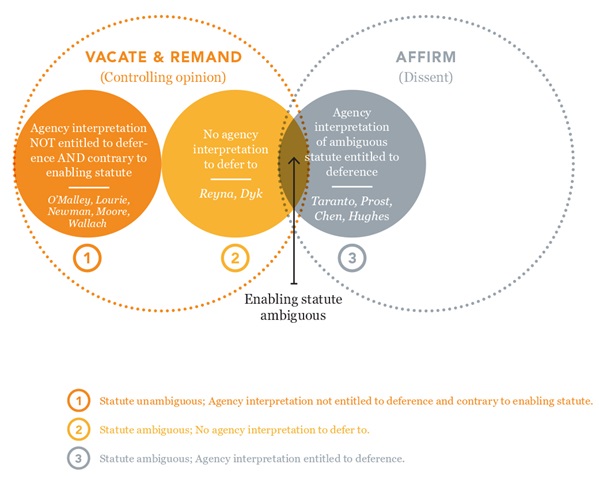Federal Circuit Finds That Petitioners Have Burden of Persuasion of Unpatentability of Claims Amended During an IPR Proceeding, For Now
Aqua Products, Inc. v. Matal, No. 15-1177 (Fed. Cir., entered October 4, 2017)
In a much anticipated decision, the Federal Circuit has narrowly decided that a patent owner moving to amend claims during an inter partes review (IPR) does not have the burden of persuasion that the claims are patentable. The decision leaves open the possibility that the burden of persuasion could be shifted to the patent owner through notice-and-comment rulemaking.
IPR proceedings arose from the America Invents Act. During an IPR, the patent owner may request amendment of challenged patent claims. Although, by statute, the petitioner challenging patent claims bears the burden of proof to establish unpatentability, a surprisingly persistent question for AIA trials has been who bears the burden of proof regarding the patentability of proposed amended claims. Prior panels of the court have placed the burden of persuasion on the patent owner.
The Federal Circuit granted en banc review to resolve two questions:
(a) When the patent owner moves to amend its claims under 35 U.S.C. § 316(d), may the PTO require the patent owner to bear the burden of persuasion, or a burden of production, regarding patentability of the amended claims as a condition of allowing them? Which burdens are permitted under 35 U.S.C. § 316(e)?
(b) When the petitioner does not challenge the patentability of a proposed amended claim, or the Board thinks the challenge is inadequate, may the Board sua sponte raise patentability challenges to such a claim? If so, where would the burden of persuasion, or a burden of production, lie?
The second question was not resolved because it was determined that this question was not raised by the facts in this case.

The en banc panel included 11 judges. The 148-page decision includes five separate opinions. Judge O’Malley authored the lead opinion, which four judges joined with two additional judges concurring in the result. The judgment of the court was expressly described as narrow, vacating the Patent Trial and Appeal Board’s (PTAB) denial of entry of Aqua Products’ motion to amend and remanding the case “for the Board to issue a final decision . . . assessing the patentability of the proposed substitute claims without placing the burden of persuasion on the patent owner.” But this may not put to rest the question of who bears the burden of persuasion.
In its most condensed form, the dispute boils down to this: 35 U.S.C. § 316(e) provides that in an IPR, “the petitioner shall have the burden of proving a proposition of unpatentability by a preponderance of the evidence.” As promulgated using notice-and-comment rulemaking, 37 C.F.R. § 42.20(c) provides that “[t]he moving party has the burden of proof to establish that it is entitled to the requested relief.” The PTAB has applied Rule 42.20 to require the patent owner, as the movant to amend, to bear the burden of persuasion that the amended claims are patentable. If § 316(e) unambiguously provides that the petitioner has the burden of proof of unpatentability of amended claims, then the regulation cannot be applied to shift the burden to the patent owner as the PTAB has done. However, if § 316(e) is ambiguous as to amended claims, then the Congressional delegation of rulemaking authority under 35 U.S.C. § 316(a), and particularly under § 316(a)(9), should require a court to afford Chevron deference to the PTO Director’s determination to place the burden of persuasion on the patent owner as the movant. To be sure, there are nuances within each of these assertions. But the fundamental question in Aqua Products became whether there is ambiguity in § 316(e) as to amended claims.
While four judges joined Judge O’Malley in finding the statute unambiguous, six judges agreed that § 316(e) is ambiguous, or at least, in Judge Taranto’s words, “35 U.S.C. § 316(e) does not unambiguously bar assigning that burden [of persuasion on the patentability of substitute claims] to the patent owner.” However, a different group of six judges agreed that the PTO had not undertaken a statutory interpretation entitled to Chevron deference. Arguing that Chevron does not apply where there is no rule, the same group of judges asserts that non-precedential Board decisions are also not entitled to deference under Chevron or Auer, and a subset of five judges found that the statutory imperative to “prescribe regulations” does not extend deference to adjudicatory rulemaking even in precedential Board decisions. In this way, Judge O’Malley’s opinion reaches the judgment of a simple majority of the court that the Board cannot place the burden of persuasion that amended claims are patentable on the patent owner. However, the other opinions of the court reveal a six-judge majority open to the possibility that notice-and-comment rulemaking would be appropriate to promulgate rules on which party has the burden of persuasion and that such a rule would be entitled to deference.
In dissent, Judge Taranto and three other judges would have affirmed the Board, finding that the application of Rule 42.20 to place the burden of persuasion on the patent owner was based on a properly promulgated regulation that reasonably resolved an ambiguity in a statute. With the express delegation of rulemaking authority under § 316(a), the dissenting judges would further have found that the adoption of Rule 42.20 was based on a reasonable statutory interpretation. In short, the dissent finds that the statute is ambiguous, the PTO was empowered to interpret the ambiguity, and the PTO’s interpretation was reasonable and is entitled to deference.
What happens next turns on how the Patent Office responds to the ruling. In the short term, the majority of the court agreed that the Patent Office should assess the patentability of proposed substitute claims in IPR proceedings without placing the burden of persuasion on the patent owner. The immediate ruling appears to favor patent owners, but it seems that at least six judges at the Federal Circuit would consider it reasonable for the Patent Office to adopt a regulation using notice-and-comment rulemaking that would place the burden of persuasion on the patent owner. Judges Reyna and Dyk left open the possibility that such a rule would be subject to Chevron deference in view of their perception of ambiguity in § 316(e), and Judges Taranto, Prost, Chen and Hughes think the current Board rules address the issue and merit Chevron deference. The remaining five judges believe that “Section §316(e) reaches every proposition of unpatentability at issue in the proceeding.” Also, because Judge Stoll did not participate in the en banc decision, we do not yet know the views of the full court on the issue.
Patent Owners should take note that even in the interim, moving to amend the claims does come with a burden of production. Judge O’Malley acknowledged that there is “a threshold showing the Board must deem satisfied before the amended claims can be considered in—i.e., ‘entered into’—an IPR.” Judge Reyna (and five other judges) would go further, asserting, “There is no disagreement that the patent owner bears a burden of production in accordance with 35 U.S.C. § 316(d).” While Judge O’Malley considered this dictum, Judge Reyna considered affirming the statutory and regulatory burdens for establishing the propriety of a motion to amend—not the patentability of the amended claims, but the entitlement to file the motion—“the judgment of this court on what the Board may and may not do with respect to the burden of production on remand in this case. To that extent, a patent owner is not excused from assisting the Board to perform its statutory obligation” to determine the patentability of the amended claims. Without regard to whether Judge Reyna’s opinion on the burden of production is binding, patent owners are on notice that the 11 participating judges found (on this record) no error in imposing the current burden of production on the patent owner.
In view of Aqua Products, a patent owner seeking to amend claims in an IPR must meet the statutory and regulatory burdens of production as previously have been applied. However, the PTAB cannot continue to place the burden of persuasion for proving patentability of the amended claims on the patent owner. This outcome was supported by a majority of the court, but the split in the reasoning means that this outcome could be subject to changes by the USPTO using notice-and-comment rulemaking.

